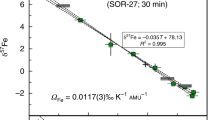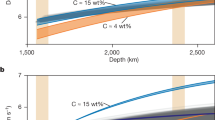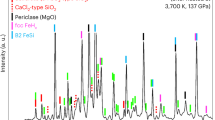Abstract
The core–mantle boundary of Earth is a region where iron-rich liquids interact with oxides and silicates in the mantle1. Iron enrichment may occur at the bottom of the mantle, leading to low seismic-wave velocities and high electrical conductivity2,3,4,5, but plausible physical processes of iron enrichment have not been suggested. Diffusion-controlled iron enrichment is inefficient because it is too slow6, although the diffusion can be fast enough along grain boundaries for some elements7. More fundamentally, experimental studies and geophysical observations show that the core is under-saturated with oxygen, implying that the mantle next to the core should be depleted in FeO. Here we show that (Mg,Fe)O in contact with iron-rich liquids leads to a morphological instability, causing blobs of iron-rich liquid to penetrate the oxide. This morphological instability is generated by the chemical potential gradient between two materials when they are not in bulk chemical equilibrium, and should be a common process in Earth’s interior. Iron-rich melt could be transported 50 to 100 kilometres away from the core–mantle boundary by this mechanism, providing an explanation for the iron-rich regions in the mantle.
This is a preview of subscription content, access via your institution
Access options
Subscribe to this journal
Receive 51 print issues and online access
$199.00 per year
only $3.90 per issue
Buy this article
- Purchase on Springer Link
- Instant access to full article PDF
Prices may be subject to local taxes which are calculated during checkout




Similar content being viewed by others
References
Lay, T., Williams, Q. & Garnero, E. J. The core–mantle boundary layer and deep Earth dynamics. Nature 392, 461–468 (1998)
Garnero, E. J. A new paradigm for Earth's core-mantle boundary. Science 304, 834–836 (2004)
Trampert, J., Deschamps, F., Resovsky, J. S. & Yuen, D. A. Probabilistic tomography maps chemical heterogeneities throughout the lower mantle. Science 306, 853–856 (2004)
Ishii, M. & Tromp, J. Normal mode and free-air gravity constraints on lateral variation in density of Earth’s mantle. Science 285, 1231–1236 (1999)
Nagao, H., Iyemori, T., Higuchi, T. & Araki, T. Lower mantle conductivity anomalies estimated from geomagnetic jerks. J. Geophys. Res. 108, 2254 (2003)
Stevenson, D. J. Models of the Earth’s core. Science 214, 611–619 (1981)
Hayden, L. A. & Watson, E. B. A diffusion mechanism for core–mantle interaction. Nature 450, 709–711 (2007)
Masters, G., Laske, G., Bolton, H. & Dziewonski, A. M. in Earth's Deep Interior (eds Karato, S. et al.) 63–87 (American Geophysical Union, 2000)
Holme, R. Electromagnetic core-mantle coupling. I. Explaining decadal changes in the length of day. Geophys. J. Int. 132, 176–180 (1998)
Buffett, B. A. Constraints on magnetic energy and mantle conductivity from the forced nutations of the Earth. J. Geophys. Res. 97, 19581–19597 (1992)
Ohta, K. et al. Electrical conductivities of pyrolitic mantle and MORB materials up to the lowermost mantle conditions. Earth Planet. Sci. Lett. 289, 497–502 (2010)
Poirier, J.-P. & LeMouel, J.-L. Does infiltration of core material into the lower mantle affect the observed geomagnetic field? Phys. Earth Planet. Inter. 73, 29–37 (1992)
Kanda, R. V. S. & Stevenson, D. J. Suction mechanism for iron entrainment into the lower mantle. Geophys. Res. Lett. 33, L02310 (2006)
Nakada, M. & Karato, S. Low viscosity of the bottom of the Earth’s mantle inferred from the analysis of Chandler wobble and tidal deformation. Phys. Earth Planet. Inter. 192/193, 68–80 (2012)
Van Orman, J. A., Fei, Y., Hauri, E. H. & Wang, J. Diffusion in MgO at high pressure: constraints on deformation mechanisms and chemical transport at the core-mantle boundary. Geophys. Res. Lett. 30 10.1029/2002GL016343 (2003)
Mullins, W. W. & Sekerka, R. F. Stability of a planar interface during solidification of a dilute binary alloy. J. Appl. Phys. 35, 444–451 (1964)
Holzapfel, C., Rubie, D. C., Frost, D. J. & Langenhorst, F. Fe-Mg interdiffusion in (Mg,Fe)SiO3 perovskite and lower mantle. Science 309, 1707–1710 (2005)
Yamazaki, D. & Irifune, T. Fe-Mg interdiffusion in magnesiowüstite up to 35 GPa. Earth Planet. Sci. Lett. 216, 301–311 (2003)
Anderson, O. L. & Isaak, D. G. Another look at the core density deficit of Earth’s outer core. Phys. Earth Planet. Inter. 131, 19–27 (2002)
Frost, D. J. et al. Partitioning of oxygen between the Earth’s mantle and core. J. Geophys. Res. 115 10.1029/2009JB006302 (2010)
Dziewonski, A. M. & Anderson, D. L. Preliminary reference Earth model. Phys. Earth Planet. Inter. 25, 297–356 (1981)
Boehler, R. Temperatures in the Earth’s core from melting point measurements of iron at high static pressures. Nature 363, 534–536 (1993)
Brandon, A. & Walker, R. J. The debate over core-mantle interaction. Earth Planet. Sci. Lett. 232, 211–225 (2005)
Sleep, N. H. Gradual entrainment of a chemical layer at the base of the mantle by overlying convection. Geophys. J. R. Astron. Soc. 95, 437–447 (1988)
Leighton, D. & Acrivos, A. The shear-induced migration of particles concentrated suspensions. J. Fluid Mech. 181, 415–439 (1987)
Labrosse, S., Hernlund, J. W. & Coltice, N. A crystallizing dense magma ocean at the base of the Earth's mantle. Nature 450, 866–869 (2007)
McNamara, A. K., Garnero, E. & Rost, S. Tracking deep mantle reservoirs with ultra-low velocity zones. Earth Planet. Sci. Lett. 299, 1–9 (2010)
Stauffer, D. & Aharony, A. Introduction to Percolation Theory (Taylor and Francis, 1992)
Smith, D. E. et al. Gravity field and internal structure of Mercury from MESSENGER. Science 336, 214–217 (2012)
Shannon, M. C. & Agee, C. B. Percolation of core melts at lower mantle conditions. Science 280, 1059–1061 (1998)
Otsuka, K., McCammon, C. & Karato, S. Tetrahedral occupancy of ferric iron in (Mg,Fe)O: implications for point defects in the Earth’s lower mantle. Phys. Earth Planet. Inter. 180, 179–188 (2010)
Otsuka, K. & Karato, S. Control of the water fugacity at high pressures and temperatures: applications to the incorporation mechanisms of water in olivine. Phys. Earth Planet. Inter. 189, 27–33 (2011)
Ringwood, A. E. & Hibberson, W. The system Fe-FeO revisited. Phys. Chem. Miner. 17, 313–319 (1990)
Seagle, C. T., Heinz, D. L., Campbell, A. J., Prakapenka, V. B. & Wanless, S. T. Melting and thermal expansion in the Fe-FeO system at high pressure. Earth Planet. Sci. Lett. 265, 655–665 (2008)
Acknowledgements
We are grateful to Z. Du, T. Hiraga, T. Kawazoe, K. Tsuno and T. Yoshino for discussions and J. Eckert, G. Amulele, Z. Du, D. Wang and R. Farla for technical support. We thank M. Zuber, J. Schubert and S. Peale for a discussion on Mercury. B. Buffett provided a useful comment on the magnetic coupling between the core and the mantle. B. Watson provided constructive criticism. This research was financially supported by the National Science Foundation under grant number EAR-0809330.
Author information
Authors and Affiliations
Contributions
Experimental studies were conducted by K.O. Theoretical interpretation and geophysical applications were done by both K.O. and S.K. Both authors wrote the paper.
Corresponding author
Ethics declarations
Competing interests
The authors declare no competing financial interests.
Supplementary information
Supplementary Information
This file contains Supplementary Text and Data, Supplementary Figures 1-4, Supplementary Table 1 and Supplementary References. (PDF 3140 kb)
Rights and permissions
About this article
Cite this article
Otsuka, K., Karato, Si. Deep penetration of molten iron into the mantle caused by a morphological instability. Nature 492, 243–246 (2012). https://doi.org/10.1038/nature11663
Received:
Accepted:
Published:
Issue Date:
DOI: https://doi.org/10.1038/nature11663
This article is cited by
-
Primordial helium extracted from the Earth’s core through magnesium oxide exsolution
Nature Geoscience (2023)
-
Core Eigenmodes and their Impact on the Earth’s Rotation
Surveys in Geophysics (2022)
-
On the role of interfacial elasticity in morphological instability of a heteroepitaxial interface
Continuum Mechanics and Thermodynamics (2021)
-
Weak magnetic field changes over the Pacific due to high conductance in lowermost mantle
Nature Geoscience (2020)
-
Iron isotope fractionation at the core–mantle boundary by thermodiffusion
Nature Geoscience (2020)
Comments
By submitting a comment you agree to abide by our Terms and Community Guidelines. If you find something abusive or that does not comply with our terms or guidelines please flag it as inappropriate.



